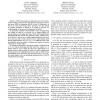Free Online Productivity Tools
i2Speak
i2Symbol
i2OCR
iTex2Img
iWeb2Print
iWeb2Shot
i2Type
iPdf2Split
iPdf2Merge
i2Bopomofo
i2Arabic
i2Style
i2Image
i2PDF
iLatex2Rtf
Sci2ools
INFOCOM
2003
IEEE
2003
IEEE
Load optimal MPLS routing with N+M labels
Abstract— MPLS is becoming an important protocol for intradomain routing. MPLS routers are offered by the major vendors and many ISPs are deploying MPLS in their IP backbones, as well as in ATM and Frame Relay networks. For this period of possible transition to MPLS, it is urgent to increase our understanding of the power and limitation of MPLS. An attraction to MPLS is the flexibility it offers in engineering the routing of traffic in a network, e.g., to support higher demands without overloading any links. Mitra and Ramakrishnan [GLOBECOM’99] showed that optimal routing solutions may be found for a diverse set of traffic engineering goals. However, for a network with N nodes (routers) and M edges (links), their MPLS implementation may use Ω(N × M) different labels. This is prohibitive since the number of labels is the number of entries needed in the router tables. We present an algorithm reducing the number of MPLS labels to N + M without increasing any link load. Our expli...
| Added | 04 Jul 2010 |
| Updated | 04 Jul 2010 |
| Type | Conference |
| Year | 2003 |
| Where | INFOCOM |
| Authors | David Applegate, Mikkel Thorup |
Comments (0)

